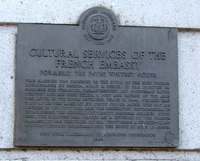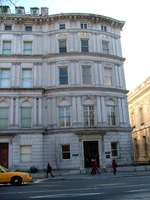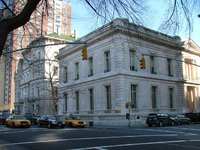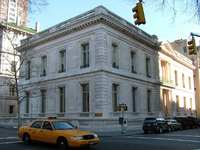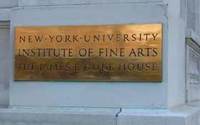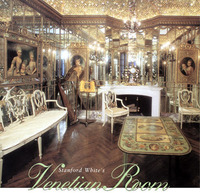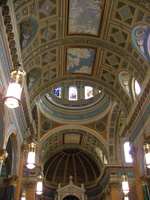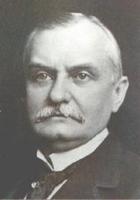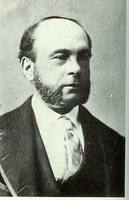Payne Whitney, Oliver Payne's most famous nephew
Many persons incorrectly associate the name "Payne Whitney" with the Esopus estate, which was willed to Harry Payne Bingham. But it is correct that William Payne Whitney was another favorite nephew of Oliver Payne. This section is a short biography of Payne Whitney.
PAYNE WHITNEY, B.A., LL.B., of New York City, capitalist, philanthropist, was born in New York City 20 March 1876, the son of William Collins and Flora (Payne) Whitney, and died at Greetree, his country place at Manhasset, Long Island, N. Y., 25 May 1927.
His mother, Flora (Payne) Whitney, was born in 1848 and died 5 February 1893, the daughter of Henry B. Payne, 1810-1896, of Cleveland, Ohio, (Hamilton College, 1832), lawyer, prominent Democrat, member of the United States House of Representatives, 1875-1877, United States Senator from Ohio, 1885-1891. Through this grandfather, Payne traced an ancestral line to William Bradford of the Mayflower, Governor of the Plymouth Colony.
Payne Whitney entered Yale University and received his Bachelor of Arts in 1898. He then studied law for three years at the Harvard Law School, receiving his Bachelor of Laws in 1901. His share in his father's large estate was increased by his own business ability; and several millions came to him from the estate of his uncle, Col. Oliver Hazard Payne, including Payne's estate in Thomasville, Georgia. Payne Whitney soon became influential in New York financial circles and a director or executive officer of several large corporations, including the Great Northern Paper Company, the First National Bank of New York, the Whitney Realty Company, and the Northern Finance Corporation.
In 1902, Payne Whitney married Helen Hay, daughter of the distinguished man of letters and statesman, John Hay, Lincoln's personal secretary and first biographer, who was United States Ambassador to Great Britain, 1897-98, and Secretary of State, 1898-1905, and his wife, Clara (Stone) Hay. Helen Hay Whitney lived at 972 Fifth Avenue until her death in 1944. The couple had two children, Mrs. Charles Shipman Payson (Joan Whitney)(5 Feb 1903 - Oct 1975) of New York City and Manhasset, well known as the co-founder of the New York Mets in 1962, and John Hay Whitney (17 Aug 1904 - Feb 1982) of New York City.
While in college, Mr. Whitney rowed for two years on the Yale crew, of which he was captain in 1898, thus following in the footsteps of his father and uncle, both of whom had been college oarsmen. He never lost his interest in the rowing achievements of his alma mater, gave liberally to their support, and was the donor of a dormitory for the crew at Gales Ferry. Interested in horse racing, he had a racing stable of his own and engaged in the raising of thoroughbred horses.
He was a constant and oftentimes anonymous benefactor of educational and charitable institutions, making large gifts to Yale, to the New York Hospital, of which he was a trustee and vice president, to the New York Public Library, of which also he was a trustee for many years and to which he gave in 1923 $12,000,000, and to many other foundations that serve the public.
After his death in 1927, the family contributed sufficient funds to Yale University to enable construction of the Payne Whitney athletic complex . This facility was completely renovated in 1997. The newly renovated Payne Whitney Gymnasium was originally constructed in 1932 under the direction of John Russell Pope. The gym is one of the most complete units of indoor facilities in the world. The building was given to the University by the Whitney family in memory of their son Payne Whitney, class of 1898. The nine and one half story structure contains training centers for crew, gymnastics, swimming, general exercise, recreational and varsity strength and conditioning and a state of the art fencing salon.
The family also contributed sufficient funds to establish the Payne Whitney Psychiatric Clinic at New York Presbyterian Hospital in l932. The Payne Whitney Clinic is a 60-bed, voluntary facility that provides state-of-the-art mental health services and related research and education programs within one of the world’s major medical centers. The Central Evaluation Service offers comprehensive evaluation and diagnostic services for patients in need of hospitalization or ambulatory treatment. The Inpatient Service provides diagnostic services and care for acutely ill adolescents, adults, and the elderly. Specialty clinical programs have been developed to meet the needs of patients and families. Services are offered for a wide range of diagnostic categories, including affective disorders, psychotic disorders and dual diagnosis.
Stanford White, often considered the most decoratively minded of the partnership of McKim, Mead & White, designed many of the most impressive and influential interiors of the era, particularly in the domestic realm. "One of his finest mature works was the residence of Payne and Helen Hay Whitney at 972 Fifth Avenue in New York City, now the building of the Cultural Services of the French Embassy. White designed and oversaw the execution of all the interiors in the house, which was still being built at the time of his death in 1906. These interiors exemplified the prevailing taste of wealthy New Yorkers and reflected a uniquely American expression of European styles."
"By the 1880s, McKim, Mead and White had become the architectural firm of choice for the elite of New York society and White was able to secure clients with large amounts of money to spend on new residences and extensive remodeling. Among his many commissions were houses for such clients as Whitelaw Reid (1837-1912), Henry William Poor (1844-1915), and Ogden Mills (1825-1910). At the same time that he worked on the Payne Whitney house, White was busy building other mansions in New York City, including ones for Mrs. William K. Vanderbilt Jr. (nee Virginia Fair, d. 1935), and Joseph Pulitzer (1847-1911)."
"At the Payne Whitney house, White worked under very favorable circumstances indeed: his clients were members of a well-established wealthy New York family who had few fixed ideas about what the building and interiors should look like. The residence at 972 Fifth Avenue was commissioned in late 1902 as a wedding present from Colonel Oliver Hazard Payne (1839-1917) for his nephew Payne Whitney upon his marriage to Helen Hay. Colonel Payne contributed more than $625,000 to the cost of the fashionable Fifth Avenue house, but he left the design choices in White's able hands. The foundation of the five-story house was laid in 1902, and work on the architectural shell progressed through 1903. By January 1904, the house was still not roofed in, but White was already planning the interiors."
"The public spaces on the ground floor were unusual, both architecturally and decoratively The dome over the entrance hall and the main staircase was constructed by the New York firm of Raphael Guastavino Fireproof Construction Company which used a laminated vaulting system. The layered tile vaults, … allowed for extremely thin, shallow vaults of great strength. The technology dated back to ancient times and had been used in many large-scale public buildings, such as Grand Central Terminal in New York City but it was relatively unusual in a domestic setting. White utilized a half-arch support for the main stair; and, more notably a broad shallow dome for the entrance hail. Supported by a circle of paired marble columns, the tile courses of the dome were ornamented with a trompe-l'oeil trellis painted by James Wall Finn … a muralist of note in the first years of the century."
▲ Quoted material taken from Jenil Sandberg article in Magazine Antiques, October 2002
The Venetian Room
Resplendent with mirrors and gilt, the Venetian room is one of architect Stanford White's masterpieces and one of his very last creations. Now returned to its original location and meticulously restored, it once again magnificently conveys the ambiance of the Gilded Age.
The Venetian room was created as the reception room in the townhouse at 972 Fifth Avenue that was a wedding gift from Oliver Payne, a financier and industrialist, for his nephew Payne Whitney and Helen Hay. Visitors entered the shallow-domed hall through massive wrought-iron doors. The Whitneys' guests were then ushered into the reception room, which had an adjoining powder room, before proceeding upstairs.
Oliver Payne commissioned America's best known architect, Stanford White, to design the house. With five stories above ground plus two under, it would have 22,000 square feet of living and service space. White began work on the plans in 1902. Construction took another five years, and during that time White repeatedly refined his ideas for the reception room. White's final drawings show the room almost exactly as it appears today, with neoclassical ornaments surrounding large mirrored panels, picture frames with putti, a lattice cove with porcelain flowers, and a parquet floor. Construction of the reception room began in April 1906 and was completed in December. White had approved the final details shortly before his death in June 1906. The only known alteration occurred in 1941, when the damaged figurative ceiling painting was replaced.
Helen Hay Whitney called this space the Venetian room. After she died in 1944, her son, John Hay Whitney, followed her wishes to have the room preserved, so it was removed before the house was sold in 1949. The French government acquired the building in 1952. The Venetian room remained in storage until 1997, when Mrs. John Hay Whitney donated the room to the French-American Foundation and provided the financial support for its restoration.
▲ Preceding text developed by Diana S Waite. Photo from frenchculture.org/art/972/venetian/
Église Saint Jean Baptiste was founded in 1882 as a national parish for the French Canadian population of New York City's Yorkville area. (Usually Catholic parishes are assigned by geographic territory; a national parish accepts persons of that nationality — in this case French-Canadian or French-speaking — regardless of location within the city.) It quickly became a spiritual center embracing many nationalities, as it does today. The area was serviced by the second avenue and third avenue elevated trains, and immigrants from many nations located there. Since 1900, the church has been under the care of the Congregation of the Blessed Sacrament, an international religious order dedicated to the Eucharist, the central sacrament of Catholic life and worship.
Invited by Father Tetreault, the first pastor, the Marist Brothers opened the school for boys in 1892 with 75 boys. "Only 15 understood French; none were interested in learning it." The Saint Ann's Academy opened in September 1894 with an unrecorded enrollment of boys from the parish, plus 15 boarders. In addition to the school, the Brothers were responsible for teaching CCD on Sundays, the parish bazaar, the monthly novena to Saint Ann and publication of the Annals of Saint Ann's Shrine. The Brothers housing also serviced several elementary schools in the neighborhood, as well as residence for many French Brothers who left France starting in 1898 when the school system there was being secularized. They stayed in New York City to learn English. The overcrowding led Brother Zéphiriny, principal of Saint Ann's, to seek other sites for the Brothers learning English. His search led him to Esopus, where he viewed the property but decided to choose property in Poughkeepsie instead because transportation to New York City and Quebec was easier from Poughkeepsie. Another interesting tidbit is that one of the teachers at Saint Ann's in the first decade of the 20th century was Brother Edmond Alphonse, who became the first treasurer of Marist Preparatory in 1942 and served as treasurer, choirmaster, and organist there for many years.
The present church building opened in the spring of 1913. Its design, drawn up by Nicholas Serracino, won first prize at the International Exhibition in Turin, Italy, in 1911. The architectural style of the church is of Italian Renaissance classical revival. A major restoration of the exterior and interior of the church was completed in late November 1997.
Situated at the back of the church in the south wall is the Shrine of Saint Anne, which evinces a devotion to the mother of the Blessed Virgin Mary that began at Saint Jean's in 1892. When the present church was opened in 1913, the Brothers took over the old church and converted it into a gymnasium, which served the school until it relocated to Queens and took the name Archbishop Molloy. Brother Zéphriny taught and lived at St. Ann's Academy, and when he opened the Marist property in Poughkeepsie, New York, he gave named it Saint Anne's Hermitage. I received my high school diploma from Saint Anne's Hermitage. When I taught at St. Ann's Academy in NYC (1950-1957) , my aunt Mary Foy Mullin told me that she had attended services in the old church. She had immigrated to New York from Ireland in 1908, and lived on the east side in the 70s area.
Thomas Fortune Ryan (1851 - 1928) born near Livingston, Virginia, the son of George Ryan, a farmer, and his wife whose maiden name was Fortune. Orphaned at 14, he moved to Baltimore MD to seek work. He took a job as an errand boy for John S. Barry, a dry good merchant, and worked for Barry for four years, working hard and gaining several promotions.
In 1872 Barry encouraged the young man to seek his fortune in New York City by trying for a position on Wall Street, a breeding ground for many self-made men. Within a year Ryan had worked for a brokerage firm as a messenger, then a broker's assistant, and in 1873. with Barry's backing, Ryan opened his own brokerage firm and also married Barry's daughter, Ada. By 1874 the new firm of Lee, Ryan and Warren purchased a seat on the New York Stock Exchange.
The 1880 census lists Ryan living in Hempstead, Queens, with his wife Ada, and four sons listed as born in Virginia: John, Thomas F, William and Allen; and three servants, all born in Ireland
When streetcars were proposed for Manhattan in 1883, Ryan organized a paper entity called New York Cable Railroad and bid against entrepreneurs Jacob Sharp and William C Whitney (Oliver Payne's brother-in-law) to gain control of a franchise for a line running along Broadway between Union Square and the Battery. To get the franchise, all three offered bribes, but Sharp's was the biggest. Ryan, Whitney and Peter Wiedner then combined to wrest control from Sharp. By 1900 the Metropolitan Streetcar Company controlled nearly all the streetcar lines in New York City.
By 1905, the Metropolitan found itself competing for ridership with the New York's popular subway system, which had been organized and financed by August Belmont. Ryan proposed a merger, which Belmont eventually accepted. Ryan sensed the financing was shaky, and by 1906 had withdrawn from the arrangement, but only after he was $35 million richer. He had a substantial interest in American Tobacco Company, and profited handsomely when that combination was broken up by the government. His New York townhouse at 858 Fifth Avenue was on the same block as Oliver Payne's, but it extended the entire block to Madison Avenue, including extensive gardens. It was designed by Carrère & Hastings.
Ryan always loved the Virginia area where he was born. In 1901 he purchased Oak Ridge, a farm which had been vacant for twenty years. Thomas Fortune Ryan became the wealthiest native-born Southerner of his generation with a net worth of over $130 million. His business interests embraced the Manhattan transit system, the American Tobacco Company, banking, the Equitable Life Assurance, the Thompson Sub-Machine Gun, railroads, Mexican rubber plantations and diamond mines in the Belgian Congo.
In 1905 Ryan bought the controlling interest in the Equitable Life Assurance Society, a deal that put him at loggerheads with the financier E. H. Harriman, who had also sought to buy the stock. Privately, Harriman complained that Ryan was ill suited to run the company, a sentiment shared by other Wall Street scions of an older moneyed class who looked down on the onetime Virginia country boy as unscrupulous, without honor, and decidedly not a gentleman. No one dared criticize him too openly, however, for Ryan was a powerful man with powerful friends.
He extensively enlarged the original Oak Ridge house into a fifty room Colonial Revival Mansion on four floors. Although not definitely proven, Ryan's architectural firm was probably the New York concern of Carrère & Hastings. Thomas Fortune Ryan used the property both as a rural retreat and as a model farm employing as many as 300 workers. A wide range of agricultural activities were pursued at this time on Oak Ridge, including an elaborate dairy operation housed in one of the largest stone dairy complexes in the United States. Saddlebred and thoroughbred horses were maintained on the Estate and entered in competitions and races from California to England.
Ryan's development of Oak Ridge is eerily similar to Oliver Hazard Payne's development of the Esopus estate. Although Payne died before completion of the horse barns west of route 9W, he clearly intended a similar use for the Esopus property, but may not have thought of horse racing but of horse shows. One local told me that he wanted to run horse shows in Esopus itself.
Thomas Fortune Ryan had an international viewpoint. His interest in the Belgian Congo stemmed from a request of King Leopold of Belgium to organize a syndicate to develop the natural resources of the Belgian Congo. Deciding that rubber production would not be profitable, Ryan organized diamond-, gold- and copper-mining operations in the Congo. Naturally, Ryan became the principal stockholder...
Ryan also liked things French. He supported French and Belgian art, including an extensive collection of Limoges enameled porcelain. Ryan was an early patron of the French sculptor Rodin. Wall paintings by the French-Canadian artist M. Suzor-Cote adorn the Breakfast Room of the Oak Ridge Mansion. He also tried to develop area near Montréal called Mont Tremblant, which is now a popular ski resort area and summer vacation spot.
His gift of St. Jean Baptist church reflects his love of things French, but also the church was close to his townhouse on Fifth Avenue. During his lifetime and under terms of the wills of Ryan and his first wife, the couple donated over $20 million to Roman Catholic causes. As a generous Catholic philanthropist, Thomas Fortune Ryan endowed Sacred Heart Cathedral in Richmond, Virginia and St. Jean Baptist in New York City, as well as funding churches, schools, and hospitals throughout the country.
References: Payne Whitney biography adapted from The New England Historical and Genealogical Register
Jenil Sandberg, "Stanford White's house for Payne Whitney in New York City", Magazine Antiques, October 2002 available on the internet at http://www.findarticles.com/cf_dls/m1026/4_162/92545136/p1/article.jhtml
Social Security Death Index on the Internet and various internet articles.
Diana S Waite, "The Venetian Room" at http://www.frenchculture.org/art/972/venetian/
Brochure on St. Jean Baptist church available in church entrance.
Article on Thomas Fortune Ryan in Dictionary of National Biography.
Internet site on Oak Ridge: http://www.oakridgeestate.com/oakridgeestate/history2.htm
Leonard A. Voegtle, fms "Go to the Land I Will Show You — The Marist Brothers in the United States",
Volume I 1885-1911 New France, New England, New York, Marist Press,c1995. pp. 136-142 gives a fuller account of the Marist Brothers at St. Jean Baptiste (1892-1934) and Saint Ann's Academy(1894-1957)
Marist University | Marist Archives & Special Collections | Contact Us | Acknowledgements
